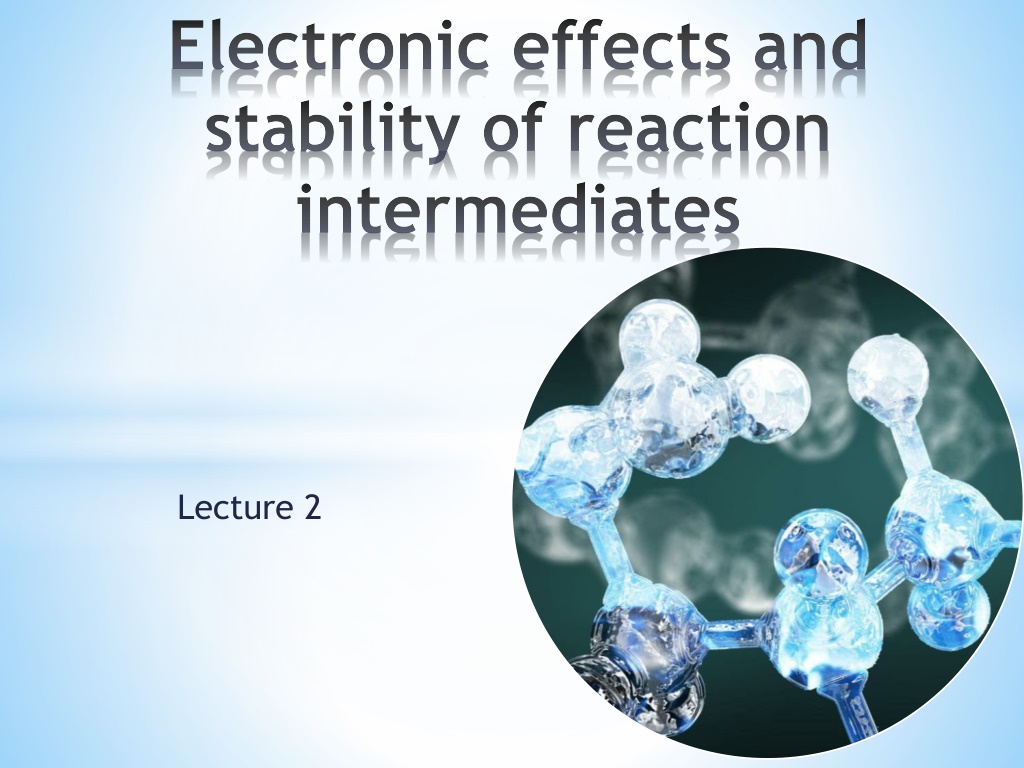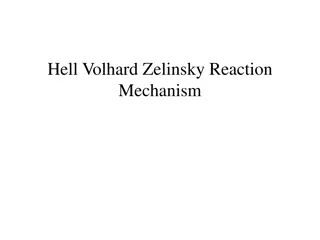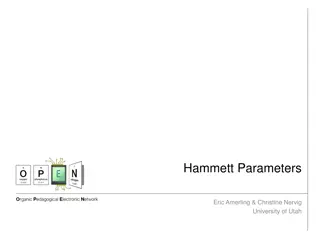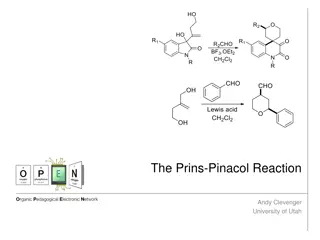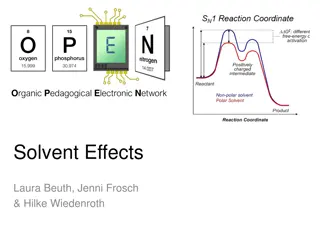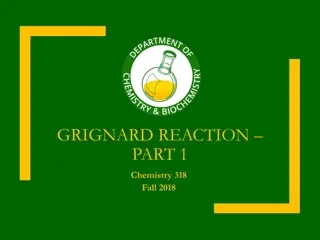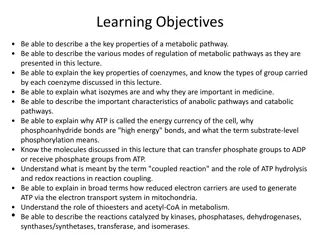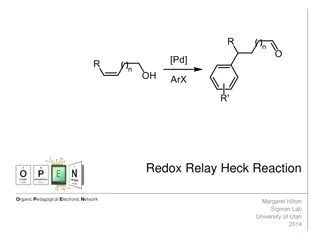Understanding Electronic Effects and Stability of Reaction Intermediates
Explore the distribution of electron density in molecules, inductive effect, mesomeric effect, resonance, and the relative stability of reaction intermediates. Learn about induction and polar covalent bonds, electron-withdrawing and electron-donating groups, and the impact of formal charges on molecular structures.
Download Presentation

Please find below an Image/Link to download the presentation.
The content on the website is provided AS IS for your information and personal use only. It may not be sold, licensed, or shared on other websites without obtaining consent from the author. Download presentation by click this link. If you encounter any issues during the download, it is possible that the publisher has removed the file from their server.
E N D
Presentation Transcript
Electronic effects and stability of reaction intermediates Lecture 2
Outline 1. Distribution of electron density in molecules. Inductive effect 2. Mesomeric effect. Resonance 3. Reaction intermediates radicals, cations, anions 4. Relative stability of reactions intermediates
9 1.5 Induction and Polar Covalent Bonds In this case, the nitrogen atom exhibits only four valence electrons. It is missing one electron, so it must bear a positive charge, which is shown like this: STEP 3 Assign a formal charge. N PRACTICE the skill 1.12 Identify any formal charges in the structures below: O C N C Al C O C (a) (b) (c) (d) (e) Cl Cl Al Cl Cl O N C C C C O Cl (f ) (g) (h) (i) 1.13 Draw a structure for each of the following ions; in each case, indicate which atom possesses the formal charge: (a) BH4 + (b) NH2 (c) C2H5 APPLY the skill 1.14 If you are having trouble paying attention during a long lecture, your levels of acetylcholine (a neurotransmitter) may be to blame.4 Identify any formal charges in acetylcholine. H H H H H O C H N C C O C C C H H H H C HHH Try Problem 1.41 need more PRACTICE? 1.5 Induction and Polar Covalent Bonds Distribution of electron density Chemists classify bonds into three categories: (1) covalent, (2) polar covalent, and (3) ionic. T ese categories emerge from the electronegativity values of the atoms sharing a bond. Electronegativity is a measure of the ability of an atom to attract electrons. Table 1.1 gives the electronegativity values for elements commonly encountered in organic chemistry. Electronegativity (Pauling, 1932) the tendency of an atom to attract electron density TABLE 1.1 ELECTRONEGATIVITYVALUESOFSOMECOMMONELEMENTS Increasing electronegativity H 2.1 Li 1.0 Be 1.5 B 2.0 C 2.5 N 3.0 O 3.5 F 4.0 Increasing electronegativity Na 0.9 Mg 1.2 Al 1.5 Si 1.8 P 2.1 S 2.5 Cl 3.0 K 0.8 Br 2.8 When two atoms form a bond, one critical consideration allows us to classify the bond: What is the dif erence in the electronegativity values of the two atoms? Below are some rough guidelines: If the dif erence in electronegativity is les s than 0.5, the electrons are considered to be equally shared between the two atoms, resulting in a covalent bond. Examples include : and C C C H
Distribution of electron density If the displacement of the electron density takes place along -bonds, inductive effect (I) takes place - a dipole is induced Negative inductive effect: d+ d- F Br I H3C H3C Cl H3C H3C NH2 H3C OH H3C O O O d+ d- H3C C H3C C H3C C H3C C N OH H OR d+ d+ d+ d- d- d- H3C CH CH2 H3C C H3C CH -I electron-withdrawing groups
Distribution of electron density Positive inductive effect: CH3 d+ d+ d+ d+ d- d- d- d- < < < H3C Cl H3C CH2 Cl H3C CH Cl H3C C Cl CH3 CH3 d+ d+ d- d- +I Li MgBr H3C H3C electron-donating groups charged groups: CH3 H3C C H3C N H3C O CH3 CH3 -I +I very strong!
Distribution of electron density Inductive effect decays quickly along the chain dd+ ddd+ d+ d- F CH3 CH2 CH2
Mesomeric effect If the displacement of the electron density takes place along -bonds, mesomeric effect (M) takes place conjugation effect Conjugation overlap of three or more adjacent p- orbitals energetically favorable Atoms capable of conjugation: atoms that are part of a double/triple bond atoms with lone pairs atoms with empty p orbitals (such as carbocations) atoms with half-filled orbitals (radicals)
Mesomeric effect 1,3-butadiene delocalization of electron density (resonance): hybrid structure resonance structures delocalization always lowers the energy of the system
Mesomeric effect +M acrylic aldehyde -M - electron-donating groups (+M-effect) - electron-withdrawing groups (-M-effect)
Mesomeric effect Mesomeric effect decays very slowly along the conjugated chain Mesomeric effect is stronger than inductive and two more examples phenol and benzoic acid
Reaction intermediates Intermediate a particle with a lifetime appreciably longer than a molecular vibration that is formed (directly or indirectly) from the reactants and reacts further to give (either directly or indirectly) the products of a chemical reaction REACTANTS INTERMEDIATE PRODUCTS REACTANTS TRANSITION STATE PRODUCTS
Reaction intermediates Intermediates are usually formed when chemical bonds are broken The leaving group can leave with the pair of electrons, empty orbital, single electron heterolytic bond cleavage carbocation carbanion homolytic bond cleavage radical In general, intermediates are unstable, but can be stabilized by the delocalization of electron density
Reaction intermediates PRODUCTS-1 major or the only INTERMEDIATE-1 more stable REACTANTS PRODUCTS-2 INTERMEDIATE-2 Compare the relative stability of particles:
